Asian conical hat
The Asian conical hat, commonly known as an Asian rice hat, coolie hat (in the UK), oriental hat or farmer's hat, is a simple style of conical hat originating in East, South and Southeast Asia; and notable in modern-day nations and regions of Bangladesh, Bhutan, China, Cambodia, Northeast India, Indonesia, Japan, Korea, Laos, Malaysia, Myanmar, Nepal, Philippines, parts of Outer Manchuria, Taiwan, and Vietnam.
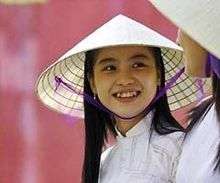
It is kept on the head by a cloth (often silk) or fiber chin strap.
Practical uses
This style of hat is used primarily as protection from the sun and rain. When made of straw or matting, it can be dipped in water and worn as an impromptu evaporative-cooling device.[1] It is also widely understood in East Asia, most notably Japan, as a symbol of Buddhism, as it is traditionally worn by pilgrims and Buddhist monks in search of alms.
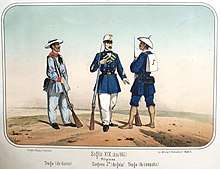
In the Philippines, the salakot is more commonly a pointed dome-shape, rather than conical, with a spike or knob finial. Unlike most other mainland Asian conical hats, it is characterized by an inner headband in addition to a chinstrap. It can be made from various materials including bamboo, rattan, nito, bottle gourd, buri straw, nipa leaves, pandan leaves, and carabao horn. The plain type is typically worn by farmers, but nobles in the pre-colonial period (and later principalia in the Spanish period) crafted ornate variations with jewels, precious metals, or tortoiseshell. These are considered heirloom objects passed down from generation to generation within families.[2][3]
The salakot was also commonly worn by native soldiers in the Spanish colonial army. It was adopted by Spanish troops in the early 18th century as part of their campaign uniform. In doing so, it became the direct precursor of the pith helmet (still called salacot or salacco in Spanish and French).[4]
In Vietnam, the nón lá ("leaf hat") forms a perfect right circular cone which tapers smoothly from the base to the apex. Special conical hats in Vietnam contain colourful hand-stitch depictions or words while the Huế varieties are famous for their nón bài thơ (lit. poem conical hats). These contain random poetic verses and Hán tự which can be revealed when the hat is directed above one's head in the sunlight. In modern times, they have become part of Vietnam's national costume.[5]
In China, it was typically associated with farmers, while mandarins wore tighter circular caps, especially in the winter.[6]
Similarly in India and Borneo, the plain conical hat was worn by commoners during their daily work, but more decoratively-colored ones were used for festivities. In Sabah, the colorful conical hat is worn for certain dances while in Assam they are hung in homes as decoration or worn by the upper classes for special occasions.
Regional names
.jpg)
English terms for the hat include sedge hat, rice hat, paddy hat, bamboo hat and sometimes coolie hat.[7]
In Southeast Asia, it is known as do'un (ដួន) in Cambodia; caping in Indonesia; koup (ກຸບ) in Laos; terendak in Malaysia; khamauk (ခမောက်) in Myanmar; salakot, sarok, sadok, s'laong, hallidung, and tabungaw among other names in the Philippines; and nón lá in Vietnam.
In East Asia it is called dǒulì (斗笠, literally meaning a "one-dǒu bamboo hat") in China; kasa (笠) in Japan; and satgat (삿갓) or gaerip (개립, 蓋笠)) in Korea.
In South Asia, it is known as Jaapi (জাপি) in Assam (India); in Bangladesh it is known as Mathal(মাথাল).[8]
Gallery
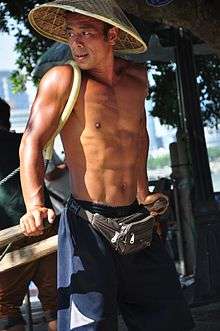 A porter in China wearing a dǒulì
A porter in China wearing a dǒulì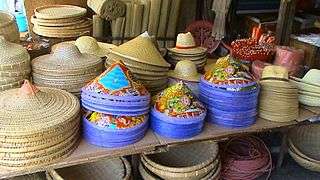
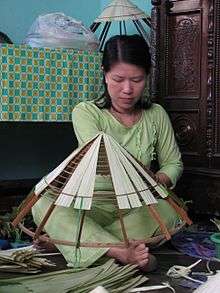 Making conical hats (nón lá) in Huế countryside, Vietnam
Making conical hats (nón lá) in Huế countryside, Vietnam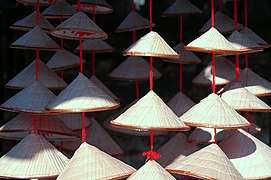 Souvenir nón lá for tourists
Souvenir nón lá for tourists A Bangladeshi rice farmer wearing Mathal(মাথাল).
A Bangladeshi rice farmer wearing Mathal(মাথাল).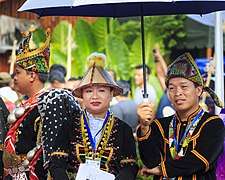
 Tortoiseshell and silver salakot from the Philippines
Tortoiseshell and silver salakot from the Philippines A silver-inlaid Filipino salakot
A silver-inlaid Filipino salakot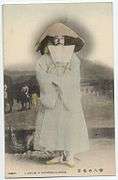 A Korean man in traditional mourning clothes and satgat
A Korean man in traditional mourning clothes and satgat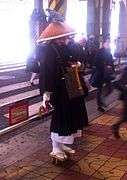
See also
- Fulani hat
- Jaapi
- Kasa (hat)
- List of hats and headgear
- Mokoliʻi, an island in Hawaii with a nickname "Chinaman's Hat"
- Pith helmet
- Pointed hat
- Salakot
- Thai farmer's hat
- Umbrella hat
References
- "Conical Hats". Nguyentientam.com. Retrieved 2012-05-23.
- Peralta, Jesus T. (2013). Salakot and Other Headgear (PDF). National Commission for Culture and the Arts (NCCA) & Intangible Cultural Heritage in the Asia-Pacific Region (ICHCAP), UNESCO. p. 232.
- Nocheseda, Elmer I. "The Filipino And The Salacot". Tagalog Dictionary. Retrieved 3 March 2020.
- Antón, Jacinto (5 December 2013). "La romántica elegancia de Salacot". Archived from the original on 3 April 2017. Retrieved 3 May 2018 – via elpais.com.
- https://www.vietnamonline.com/culture/non-la.html
- Encyclopædia Britannica, Eleventh Edition. New York: Encyclopædia Britannica, Inc. 1910. pp. 173.
- "Coolie hat - Definition and More from the Free Merriam-Webster Dictionary".
- "Bamboo Craft". Banglapedia.
External links
| Wikimedia Commons has media related to Conical straw hats. |

